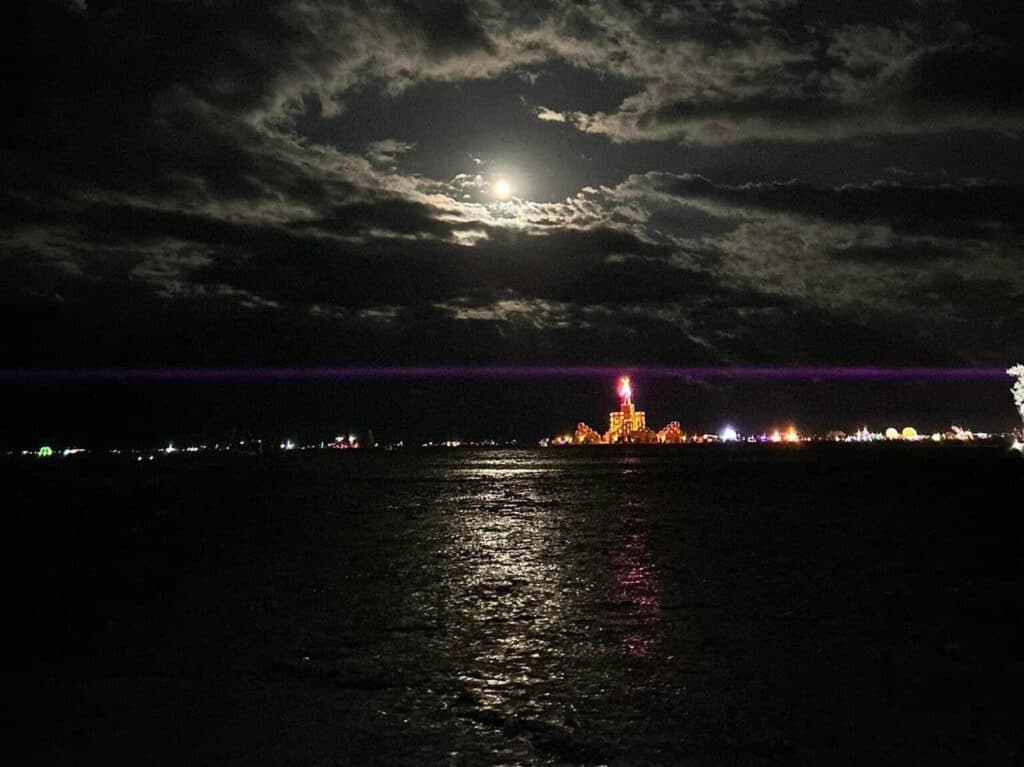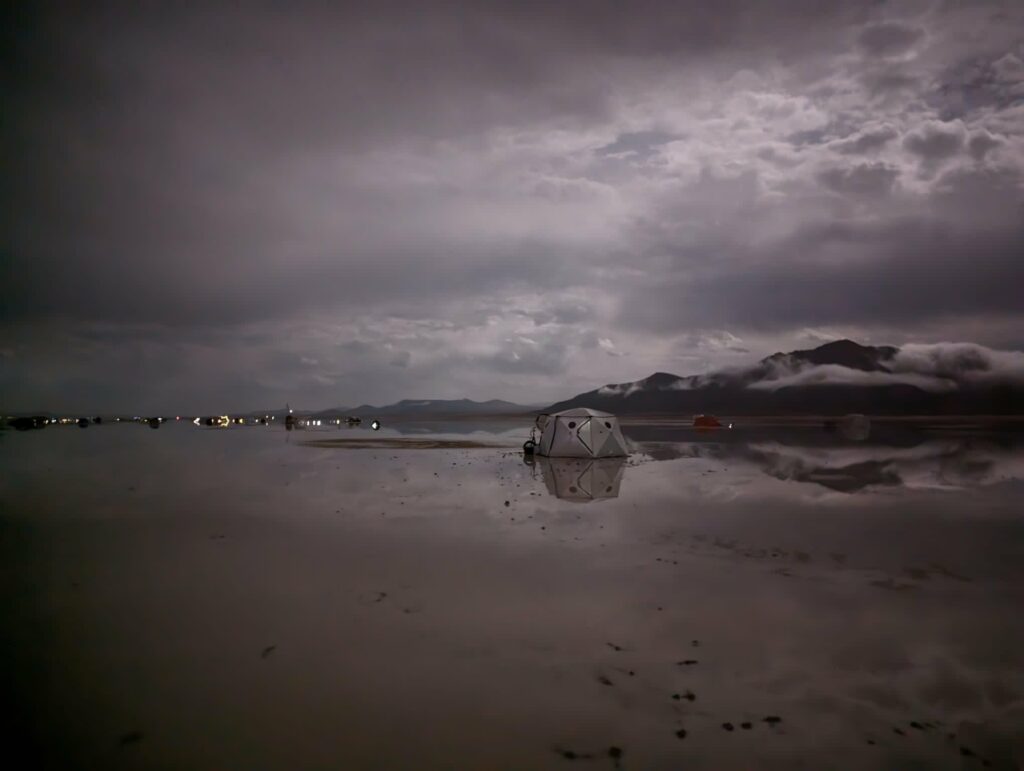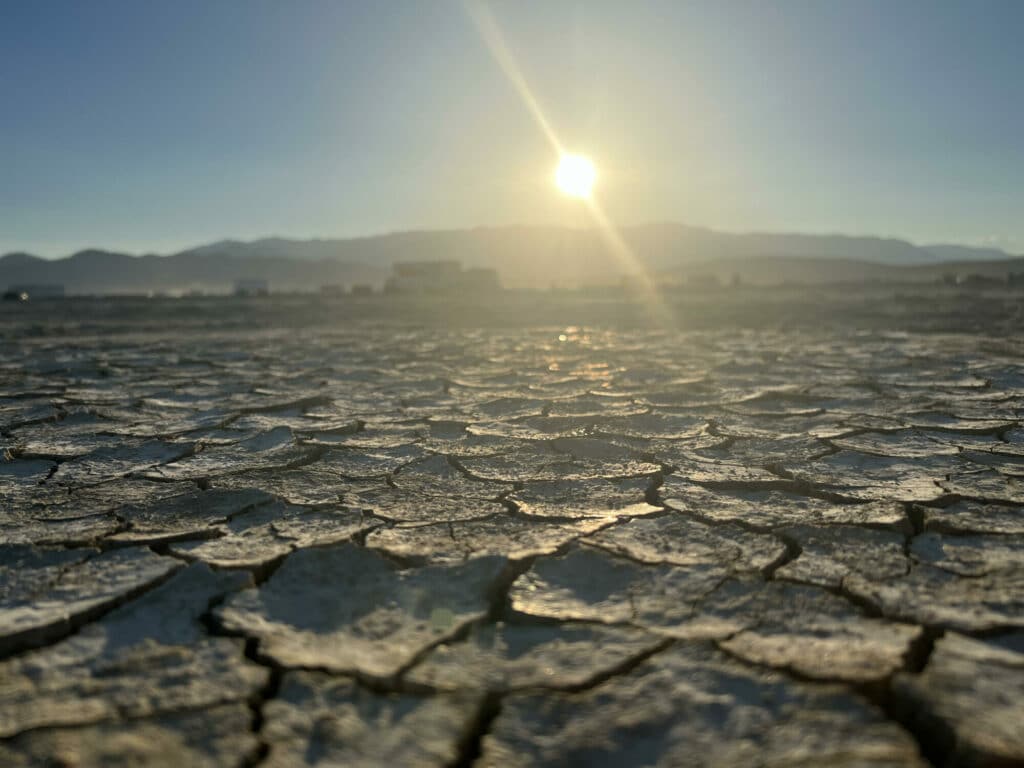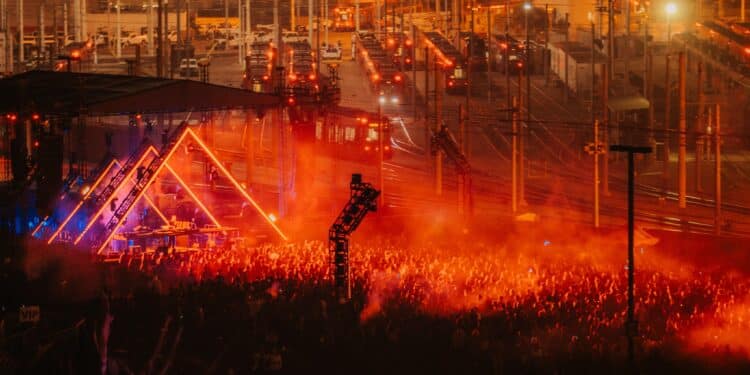The mainstream media portrayed Burning Man 2023 as a miserable, muddy disaster. Burners themselves tell a different story.
2023 marked an unprecedented year for Burning Man. Flash floods stranded roughly 72,000 attendees and forced the Burning Man Project to push its namesake effigy burning ceremony from Saturday, September 2, to Monday, September 4, for the first time in its 37-year history.
It was all in good fun for the gathering’s most tried-and-true participants, however. The haphazard turn of events hardly rained on their parade.
That’s not to say it was a walk in the proverbial park. Early Friday, September 1st, dark storm clouds crept over the foothills lining the horizon and enshrouded the Black Rock Desert in Nevada. The torrential downpour that followed transformed its flat, featureless lakebed into a mud pit several miles in diameter. Owing to the distinctive properties of the dust coating its surface, the playa behaved like quick-dry concrete that froze thousands of cars, trucks, RVs, and mutant vehicles in their tracks.
Some driving four-wheel-drive vehicles made a mad dash to escape. Those with all-terrain tires were lucky enough to reach the roads. The rest found themselves even more stranded than they would have been had they stayed put.
Most who remained at their camps fared much better. True Burners tend to be radically self-reliant, a motley crew of artists, scientists, and survivalists who haul millions of dollars worth of infrastructure to build a temporary dreamscape in the desert each year. Under the circumstances, they repurposed these assets to provide their members with the means to weather the storm.
The worst of the rain let up by Saturday, but the lake of mud remained. Burners began to venture out with trash bags duct taped around their feet — a cartoonish and physically comedic procession in which everyone lugged a 50-pound weight around with each step. Soundcamps like Ego Trip and Questionmark managed to host dance parties. Needless to say, revelers danced much differently than usual.
Drizzling rain continued off and on through the rest of the day. Without the fire trucks and medical staff who usually encircle it in case of emergencies, the Man Burn at the center of the grounds was postponed indefinitely.
The impromptu parties that took place instead put the excesses of legendary rock stars to shame. Tents, shift pods, and even box trucks devolved into lurid dens of debauchery. Without the sleight of hand offered by immersive production values, the human condition’s darkest aspects took center stage.

The Burning Man Project (known colloquially as the Org) faced a PR undertaking bigger than any it had ever encountered.
CNN reported that the playa received two or three months’ worth of rain in only 24 hours and that President Biden had been briefed on the natural disaster. “We’re in touch with the local people,” he declared. “We’re paying attention. We ought to be getting everybody out of there.”
More sensationalist outlets falsely attributed a death that occurred on site on Thursday to the storm. Rumors of Ebola outbreaks and even cannibalism among attendees also circulated far and wide on social media.
Org CEO Marian Goodell, who reportedly declined assistance from The National Guard, did her part to quell the media circus in a statement to NBC News. “People are here as they normally would [be] with everything they need to survive,” she told the outlet via video chat from the playa. “There’s no big sense of panic; we’re not doing an evacuation. We’re waiting for the ground to dry.”
The Org also published a “2023 Wet Playa Survival Guide” on its website. Although comprehensive, it mentioned nothing about the efficacy of cowboy boots in traversing the mud (this writer still maintains that they are the best footwear option, no matter the state of the playa).
A large proportion of Org constituents took the sequence of events in stride. During a conversation in First Camp, where most Burning Man Project staff reside during the event, one Burner who asked to remain anonymous told me he chose to stay on-site instead of retreating to his home in nearby Gerlach.
“If the playa was like this in the regular part of the season, you’d have to drag me out here by horses and chase me with wolves,” he said. “But because it’s Burning Man, I participate rain or shine.”
A Burner who goes by Danger and camps with the Org’s Media Mecca told me that what he witnessed during the storm inspired him. “Everyone comes together and survives,” he said. “Burning Man is all about radical self-reliance, but it’s cool to see this moment where people have to come together — not just the staff we have here, but normal people.”
For all the challenges posed by the rainstorm, a substantial swath of the core Burner community echoed a similar sentiment: A disaster of this magnitude was precisely what the world-famous gathering needed.

How it Started
Burning Man debuted in San Francisco’s Baker Beach in 1986 and drew only 20 people. Jerry James and the late Larry Harvey took inspiration from nearby summer solstice bonfires when organizing these seminal outings.
The Cacophony Society — a local group of pranksters and performance artists — got involved in early editions of the growing gathering. Their influence guides the culture of the event to this day, especially its heavy emphasis on active participation. When the police stepped in and prevented Harvey and James from burning the wooden Man they had built for the 1990 event, it was a Cacophonist named John Law who suggested they relocate to the Black Rock Desert in Nevada.
The Cacophony Society was already planning an event called Zone Trip #4: Bad Day At Black Rock, and artists like Mel Lyons had built surrealist art installations on the playa for a long time prior. The 1991 edition of Burning Man merged with Zone Trip #4, and the event has taken place in the BRD annually ever since (save for two fallow years during the COVID pandemic).
The picturesque mystique of the Black Rock Desert has drawn more and more participants every year. The average burner’s level of participation hasn’t grown in step with attendance, however.
How it’s Going
Between 1995 and 2010, Burner culture underwent a gradual shift. A growing circle of posh socialites came to eclipse the authentic kernel of coarse adventurers at its core from the public eye. These opulent types often appeared more interested in buying a ticket and taking a ride than helping build the temporary city itself.
The Burning Man Project arguably could have done more to stave off this influence. A staff member who asked to remain unnamed told me that the organizers of certain “plug-and-play” camps (which discreetly offer wealthy burners a comfortable playa experience for hefty prices) make sizeable donations to the Org. The resulting conflict of interest often prevents the Org from consistently enforcing the gathering’s core principle of decommodification (it often justifies this by invoking another principle, radical inclusion).
Following the 2018 installment of Burning Man, Marian Goodall, the CEO, announced plans to work toward “Cultural Course Correcting.” Little changed by the following year.
In 2020, of course, everything changed — but no thanks to the Org. The unfolding COVID pandemic forced it to postpone the 2020 and 2021 editions, leading a substantial subset of the Burner community to organize unstructured gatherings on the playa without its help.
When Burning Man returned at last in 2022, 80,000 participants gleefully flocked to the playa. That year’s extreme heat and dust storms dashed their collective enthusiasm, though. While plenty still enjoyed themselves, the resulting shift in Burner morale was palpable, as was an apparent drop in ticket demand ahead of this year’s edition.

Blame it on the Rain
This year’s savage rainstorm surely created even more harrowing crises for innumerable Burners. Some of them may never come back. But those who stayed calm, came together, and made the best of the situation couldn’t help but chuckle as bits and pieces of the dire media narrative trickled in from the default world. As the general public postulated about Burners languishing in the mud, the real ones enjoyed a party never to be forgotten while strengthening meaningful bonds through communal effort.
When the Man finally burned on Monday, September 4, the effigy’s pitiful size compared to years prior made the ceremony all the more anticlimactic. It barely looked like a glowing speck on the horizon from the temporary city’s central Esplanade road. The fireworks and pyrotechnics were decent, at least.
Burning Man’s Blue Monday wasn’t so bad, though. It’s neither the size nor the scale of the spectacle that makes the event what it is. The playa is the playa whether a Man is burned on it at all.
It’s hard to say how long it will take for participants at every level of the gathering to sift through the aftermath and process of Burning Man 2023. More will surely think twice before returning next year, if ever again. The Burners who relish opportunities to confront new and exciting challenges on the playa will remain regardless. For them, this is what that thing in the desert has always been about.
…Actually, you know what? Scratch all of that. It was awful. Burning Man is always awful. Whatever you do, please don’t go.








